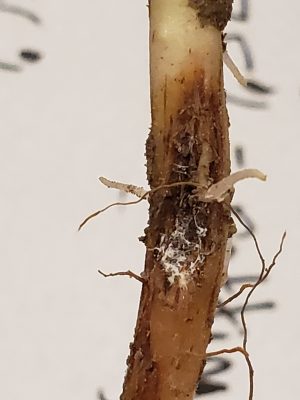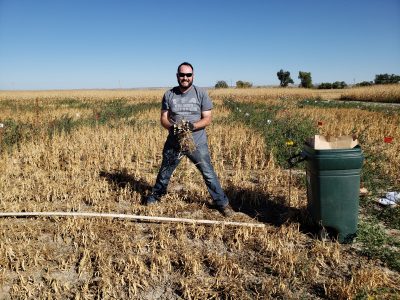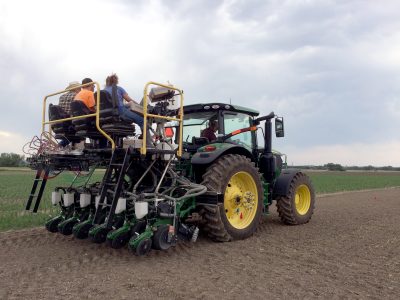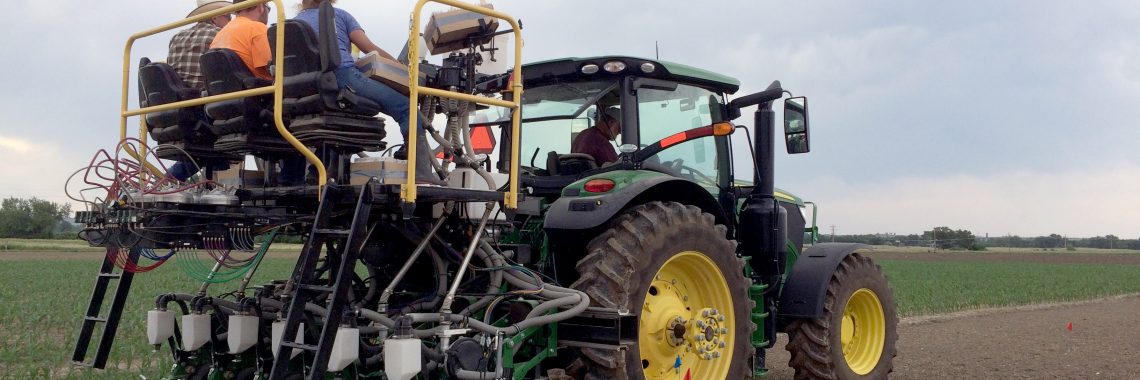The next time you settle down to enjoy a steaming bowl of chili or a spicy bean burrito, thank a dry bean producer. Dry edible beans, such as pinto, navy, kidney, black and white beans, are grown in 30 states, where 1.34 million acres were harvested in 2021. Wyoming was ranked eighth for dry bean production, according to 2014 data, and is a leading producer of bright, packaging-quality pinto beans. In Wyoming, dry bean production in 2007–2016 ranged from 25,000 acres to 49,000 acres, and the top producing areas were the Big Horn Basin and the Southeast corner of the state. Wyoming also produces certified dry bean seed.

One challenge of dry bean production in Wyoming and neighboring states is soil-borne disease, particularly root rot diseases. Several pathogens cause root rot diseases, and Rhizoctonia and Fusarium root rot are common in our region. The severity of disease depends on environmental conditions, soil compaction, variety and cropping history, and growers have limited options to address these issues. For the past eight seasons, our lab has conducted 11 field studies, including a master’s project by graduate student Kyle Webber that investigated ways to manage dry bean root rot. Because more than half of Wyoming’s dry bean production is pinto beans, we studied several pinto bean varieties using an integrated approach to root rot disease management.
Dry bean root rot diseases limit root growth, which reduces crop yields. Stress factors such as soil compaction and dry or saturated soil can increase disease severity. Fusarium root rot (Fusarium solani f. sp. phaseoli) is found throughout the world in areas where dry beans are grown. Fusarium root rot can almost destroy a bean crop when plants are stressed by drought, soil compaction, soil saturation or oxygen stress.
Fusarium root rot often is found in association with other disease organisms such as Rhizoctonia solani, in what we call a disease complex. In a study conducted in Nebraska, respective yield reductions of 52% and 42% for Great Northern beans and pinto beans were observed because of Fusarium root rot. In separate surveys conducted in Colorado in 1971 and 1972, pinto bean field yield losses averaged 27–62%, with some individual field losses as high as 89%. Commonly grown varieties are equally susceptible to root rots in this region, but some varieties are more tolerant to Fusarium infection than other varieties. If producers are going to have reliable yields, we need to continue screening new and existing varieties for tolerance to fungal root rot diseases and explore potential chemical controls.
Testing an integrated approach
Our goal was to determine if a single, in-furrow fungicide application at planting, varietal selection, and deep tillage to alleviate soil compaction would protect the dry bean crop from the effects of soil-borne disease. The specific objectives of our study were to:
- Compare the efficacy of two commercially available in-furrow fungicides for Rhizoctonia and Fusarium disease suppression.
- Evaluate up to five locally adapted pinto bean varieties in the presence of disease.
- Investigate the utility of deep tillage on bean root development and how it affects root disease.
These studies took place over two years, from 2018 to 2019, at the University of Wyoming’s Agricultural Experiment Station research sites, Powell Research and Extension Center (PREC) and James C. Hageman Sustainable Agriculture Research and Extension Center (SAREC). With support from Bayer and BASF, we also investigated other fungicides and methods of application in seven separate field fungicide efficacy studies conducted at the UW SAREC research site from 2015 to 2021.
Results… some expected, some surprising, some meh

With our deep-ripping tillage treatments, we were able to reduce soil compaction; however, there were no positive benefits to disease suppression or yield compared to our conventional field preparation. It is widely assumed that dry bean roots can tolerate root rot disease pressure more easily by having a healthy, extensive root system. Bean roots that are suppressed by the compaction layer found in some agricultural fields are much more prone to the effects of soil-borne diseases. Although this is not the first time science didn’t back up conventional wisdom, it’s possible that the lighter soils found at SAREC and PREC are less prone to soil compaction layers, and the roots were not stressed enough.
Because of genetic variances in breeding, we found significant differences among pinto bean varieties in terms of disease susceptibility and yields (Table 1). Sundance, a newer, slow-darkening variety whose seed does not darken with age on store shelves, had the lowest average disease severity; however, this did not translate to greater yields, most likely due to varietal differences. The other varieties had variable yield results depending on the experimental conditions. Othello, a common variety grown in Wyoming, is very susceptible to root rot infection; however, it was among the highest yielders in the presence of disease. While none of these varieties are resistant to root rot disease (all the varieties tested had 100% of the roots infected to some degree), dry beans in general can compensate for root diseases by producing extra roots once the main tap root becomes rotted. In fact, heavily infected bean plants frequently fail to show any visible above-ground symptoms. All the tested varieties in our studies have displayed very few above-ground symptoms, but under limited water conditions this could be a different story, because the newer roots that develop tend to be shallower than the deeper main tap root.
In-furrow fungicide treatments, in which fungicide is applied in furrows as seed is planted, were for the most part ineffective when used in the integrated study. However, in the fungicide efficacy trials, which investigated different fungicide chemistries than those used in the integrated study, we did reduce early- to mid-season disease by almost 50% in some cases. Despite reductions in disease, in most studies this did not result in yield increases compared to the untreated treatments, and sometimes the fungicide applications hindered bean emergence. In 1 out of 11 studies, we did see significant yield increases with fungicide treatment. Fungicide effectiveness is time-sensitive, meaning once applied in the environment, compounds are subject to degradation and lose effectiveness over time. Unfortunately, these fungal pathogens can continue to attack the bean roots all season long. As a rule of thumb, from our years of experimentation in various cropping and disease situations, fungicide applied as seed treatment results in several weeks of protection, in-furrow applications can protect for up to a month, and in-furrow application plus a foliar application to the leaves can extend protection for 1.5 to 2 months.
So, what have we learned about managing root rot disease in Wyoming’s dry beans? Alleviating stressors such as soil compaction only makes sense to keep roots growing and healthy. Lack of effects from our attempts to reduce soil compaction probably were due to the level of compaction we were able to create in our experiment. The degree of soil compaction can vary among soil types, and soils that have higher percentage of clay and silt have more of a problem with soil compaction compared to the lighter soils found at the research sites. Under a true compaction problem that some farming operations can have, reducing compaction should have a positive effect on the health of plants.
As for varieties, it’s clear there is room for improvement in terms of increased plant resistance to these root rot organisms. Dry bean disease resistance breeding is an ongoing process, but it is difficult because of the number of genes involved for resistance. In any event, our local varieties, at least in our studies, seem to do relatively well under high disease incidence.
The viability of using fungicides is less clear. We were able to reduce severity, but some fungicides caused some reduced crop emergence and short-lived plant injury. Based on our results, it’s difficult to justify the additional expense of in-furrow and foliar fungicide applications. At the bare minimum, growers should use fungicide-treated seed, because it’s relatively inexpensive and reduces early infections. Despite some of our disappointing results, we still believe an integrated approach is the best bet to manage dry bean root rot. To better answer these questions, future research is required in field environments that are more conducive to plant stressors so these integrated approaches can be further tested.

Reprinted from Reflections, the College of Agriculture, Life Sciences and Natural Resources research magazine.
By William Stump, Associate Professor, (307) 766-2062, wstump@uwyo.edu; Kyle Webber, Graduate Student; Wendy Cecil, Research Associate, Department of Plant Sciences.






